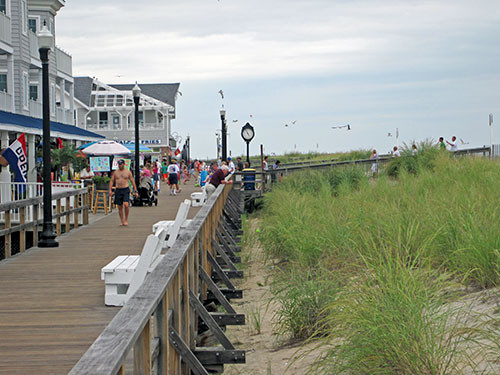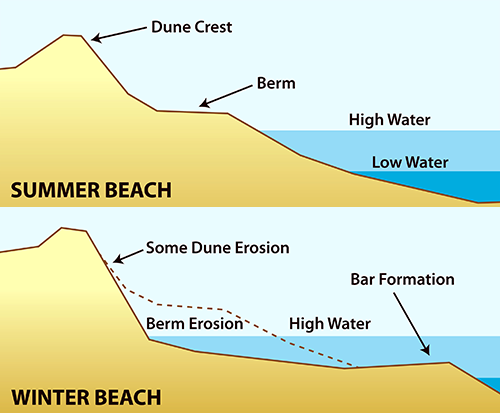Learning to Love the Dune in Bethany Beach
Bill Nuttle ·The seawall was an admission that everything tried so far was not working.
This past summer I discovered that Bethany Beach, Delaware, has something that few other beach resorts can claim — a 16 foot dune. Families strolling the boardwalk or hanging out to eat ice cream gaze out on to a rising slope of dune grass instead of ocean surf playing on a sunlit beach. The beach and the surf are there, to be sure, and the dune is there to make sure the beach stays where it is.

The Corps of Engineers constructed this dune in 2007 as the latest step in a decades-long fight to preserve the town. Bethany Beach was built right on top of a natural dune field. This was the highest ground probably within a mile of the beach, and people wanted to enjoy the view. Then, in the 1930s and 1940s, groins were built to try to stabilize a beach that was beginning to disappear. Groins are low bulkheads that extend out into the water perpendicular to the beach to trap sand carried in the long-shore drift. Unfortunately, the beach continued to slip away. No one yet realized that people had destabilized the entire beach by disturbing the natural dune.
Beaches are a dynamic element of the coastal landscape, constantly responding to changing weather and wave conditions. Seasonally, sand accumulates just above the high tide level during the relatively calm late spring and summer. During the fall and winter the annual cycle of sea level is at its peak and waves are higher. As a result, sand is removed from the beach and accumulates in an offshore bar. Sand, accumulated in the dune well above the level of normal high tides, contributes to the ability of the beach to withstand extreme events. During severe storms the dune serves as a barrier that prevents the surge from washing completely over the beach, and it also provides a reserve supply of sand to prevent complete loss of the beach by erosion.

By 2007, residents of Bethany Beach were ready to take drastic measures. When the groins proved insufficient, sand was dredged from the bottom a couple of miles offshore and pumped in to re-nourish the beach. Dredging was tried first in 1961 and 1962, then again in 1989 and several more times during the 1990s. Somewhere along the line a seawall was built inside the boardwalk to prevent the steadily encroaching surf from destroying the shops and apartment buildings overlooking the beach. The seawall was an admission everything tried so far to maintain the beach was not working.
Not everyone was happy when engineers began building the dune in September 2007, but there is little argument where Bethany Beach would be today without it. The dune is part of a long-term plan to maintain the beach that includes monitoring changes and plans to re-nourish the beach every five years. The plan paid for itself within the first two years when the dune prevented storm surge during a severe northeaster storm in 2009 from inundating the town.
Hurricane Sandy, in October 2012, provided people all along the east coast of the U.S. with a timely lesson on beach dynamics. Bethany Beach was spared from its worst effects when Sandy veered north; however, flooding and over-wash closed a section of the main coastal highway several miles north along the Delaware shore. Sandy’s clearest lesson was received by the hardest hit communities along the New Jersey coast. Communities protected behind a dune had less damage than communities with no dune between them and the beach. As a result, more coastal towns are now interested to follow the example of Bethany Beach.

